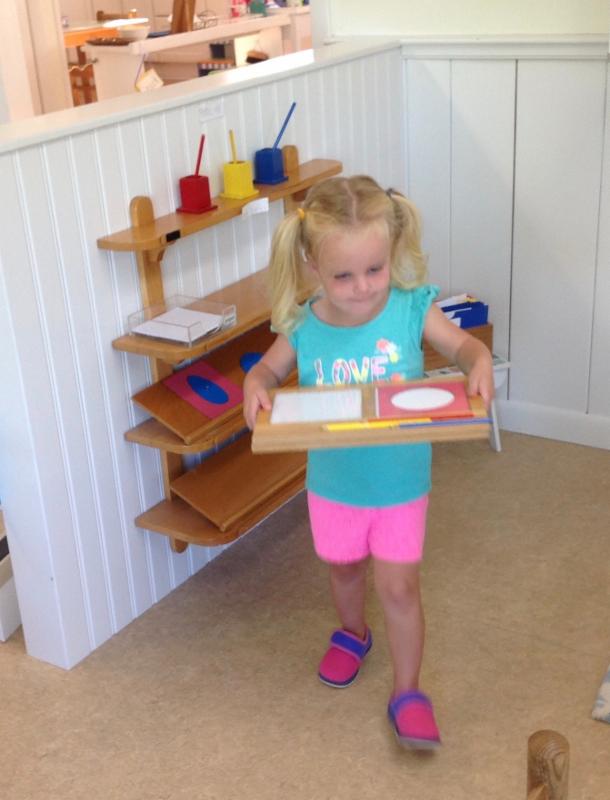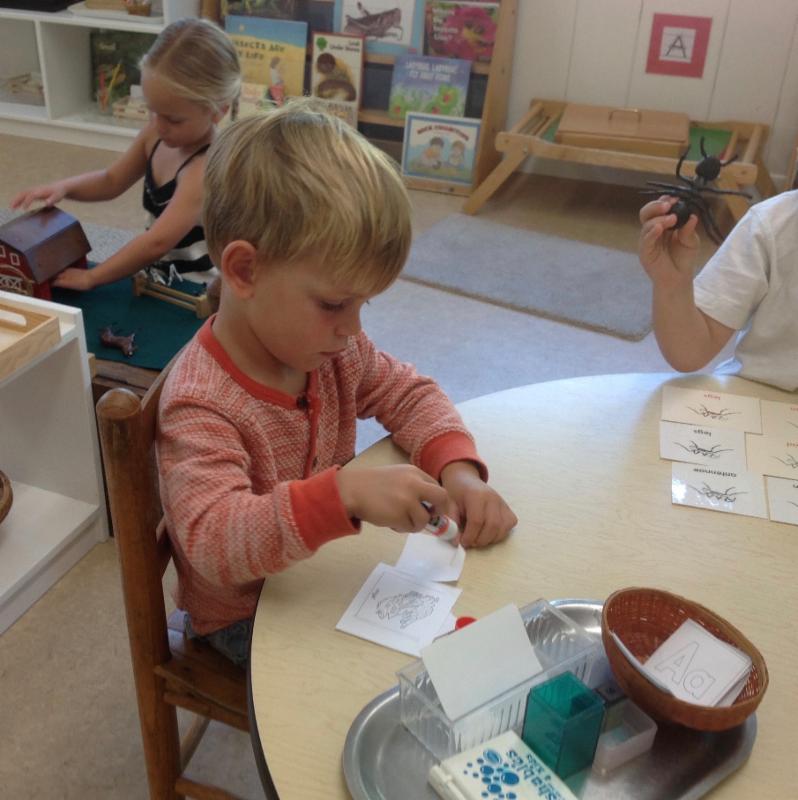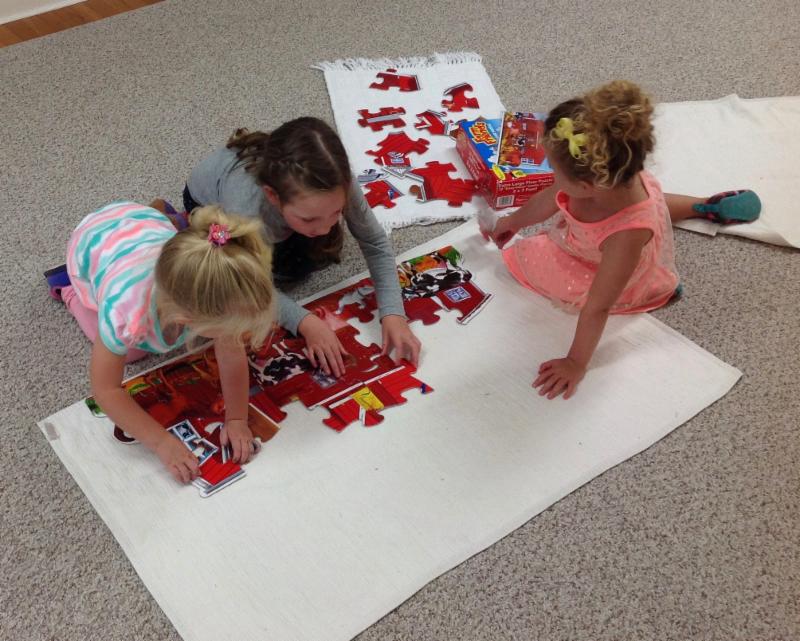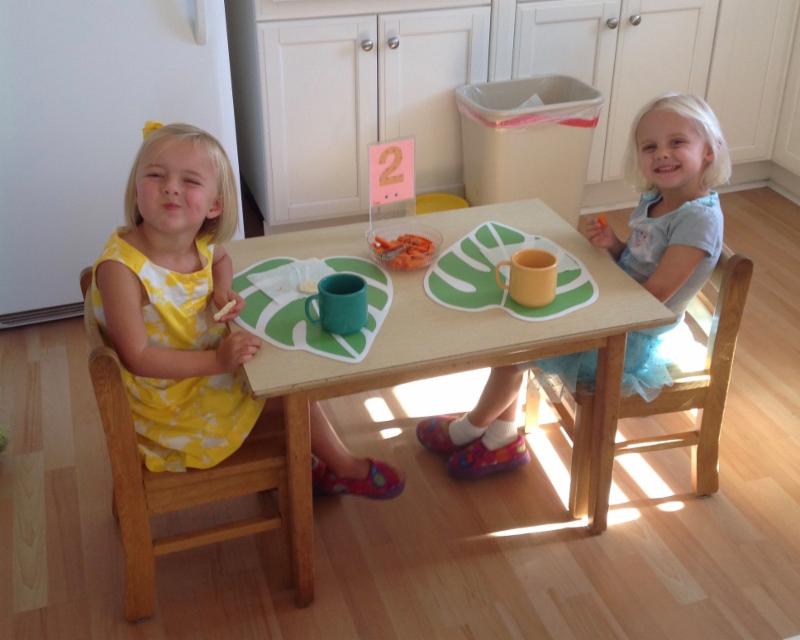| |
|
|
Montessori Children's House of Nantucket
October 2016
|
|
|
|
|
 |
 |
 |
 |
 |
 |
 |
 |
 |
 |
 |
 |
 |
 |
The education of even a small child, therefore, does not aim at preparing him for school, but for life.
-Dr. Montessori
|
|
Building Independence
Lythcott-Haims's approach closely aligns with Montessori, as both emphasize the benefit of providing children with opportunities to complete daily tasks independently in preparation for later life. Additionally, by directly experiencing reality, children develop problem solving abilities rather than expecting or needing adult intervention to achieve success.
Lythcott-Haims's TED talk, linked below, shares valuable insights into what we as adults can do to help our children master the skills that will serve them throughout their lifetimes. While you watch, consider the similarities between her perspective and Montessori's words:
My vision of the future is no longer of people taking exams and proceeding from secondary school to University but of passing from one stage of independence to a higher, by means of their own activity and effort of will.
-Dr. Montessori
Childhood to Adolescence
|
|
|
How to Raise Successful Kids Without Overparenting
|
|
|
Look at what has happened to the sort of education provided by parents and teachers! They tell the child, "Come on. You must buckle down and study. You must get that diploma. You must get such and such a job. Otherwise how will you live?
Parents and teachers today forget to voice the words that were once the very cornerstone of education:
"All men are brothers."
-Dr. Montessori, Education and Peace: 1937
|
|
Practical Life
Practical Life is one of the four original curriculum areas developed by Maria Montessori. The activities found here are specially designed to develop independence, concentration, coordination of movement, and a sense of order. This area is considered a bridge between home and school because the materials are familiar to the child and representative of his/her home environment.
Practical Life activities offer opportunities to practice pouring, scooping, twisting, squeezing, lacing and stringing as well as care of self work like buttoning, zipping, and snapping. Here students also participate in caring for their school by folding laundry, sweeping, preparing food, polishing, scrubbing chairs, and watering plants. Having seen parents and caregivers do similar work at home, these real-life tasks are both meaningful and appealing to young children.
|
|
Give and do what is necessary for the child to act for himself.
-Dr. Montessori
|
|
A recent article from The Atlantic [online, 9/27/16] by Jessica Levy t
itled
How Daycare Became School
,
describes a shift in the focus of many early childhood education programs in the United States over the course of the last decade. The article also quotes Gina Lofquist, the senior director of teacher education for the American Montessori Society (MCHN is an AMS member school and our staff is also credentialed through the organization).
Levy explains that, while today parents have many more choices when searching for an early childhood education program for their children, especially those that offer a more academic curriculum, parents should be weary of placing too many standards or expectations on young children. Unfortunately, in programs where this is the case,
"c
hildren are often rushed from one activity to the next...without sufficient time to play and explore at their own pace."
The Children's House has always been a
school
, similar to how we refer to the activities found throughout the building as
work
. The preschool child's work is to play, explore, discover, and in doing so, learn. Here at MCHN we believe a school for preschool-age children is a place where students are supported in developing independence, self-assurance, inner discipline, and a love of learning.
The American Academy of Pediatrics agrees, and is quoted in the article:
"A good preschool tries to help children gain self-confidence, become more independent, and develop interpersonal skills"
Additionally, the article notes that
the AAP, "acknowledges concerns about programs that are created to cater to parents' fear or guilt rather than children's needs:
"'Be wary of programs that claim to teach academic skills or 'speed up' children's intellectual development. From a developmental standpoint, most preschoolers are not yet ready to begin formal education, and pushing them will only prejudice them against learning.'"
In Montessori classrooms, the teacher meets the child where he is in his development and guides him toward work that will build skills and confidence simultaneously. By focusing on what students already know and what they are ready to learn, the staff at Children's House encourages each student to challenge herself while also setting her up for success. MCHN deeply values this individualized approach, as it provides our young students with the time, space, and support they need to grow at their own pace.
|
|
The best time to teach a child is when the child is ready to learn.
-Dr. Montessori
|
|
|
|
|
Montessori educators are trained in adapting each material to the developmental level of the student.
In a mixed-age classroom like ours, the same materials are used by children 2 years 9 months to 6 years old. It is the work of the teacher to give a developmentally appropriate presentation.
|
Through observation, educators gain a deep understanding of each child's skill level.
Careful observation enables the MCHN staff to meet each child where he or she is, and guide them to progress in their abilities through increasingly challenging extensions and variations of the materials.
|
Students gain confidence and develop independence.
While there is a wide variety of work available to students, all materials are presented to the student in a consistent manner.
Once students learn the process, they are empowered to select work independently from all curriculum areas.
|
|
 |
Below is an excerpt from an August 29, 2016 blog post where
Sean Slade [Huffington
Post
],
Senior Director of Global Outreach at ASCD (
Association for Supervision and Curriculum Development) explores the potential benefits of focusing on "the process of learning and a little less on the outcomes" in the field of education.
In the post, Slade details what engagement might look like in a classroom. Many of the changes he hopes to see are hallmarks of Montessori programs and daily practice here at Children's House. Slade advocates for teachers to learn "what inspires and motivates" their students, and to be flexible and spontaneous in order to respond to student interests. He also notes that engagement is a cooperative effort where students have a role to play, which is very much the case at MCHN as well.
At Children's House, and in Montessori classrooms worldwide, the child, environment and teacher form a learning triangle, with each side impacting the others, and with no single source of information or knowledge. The teacher carefully creates and maintains a "living" environment, one that is continuously adjusted based on her close observation of each child and his/her interactions with the materials.
Within the environment, children have the freedom to choose where they work, what they would like to work on, and if they would like to work independently or with friends. With gentle guidance from the teacher, students are supported in following their individual interests and developing their personal strengths, through work designed to meet their level of development.
Inspiring a sense of wonder and love of learning has long been the Children's House mission. At this early stage in life, children are learning how to learn. We support our students in becoming active seekers of knowledge, in preparation for the lifelong pursuit of personal growth and development.
|
"What would happen if we focused on the process of learning rather than just
the metric to judge it by? Would it change that much? Probably.
It would certainly change how we taught and it would also change what we taught. It may even change the people who we are trying to embed in the learning process - the students themselves...
[W]
e know that students who are engaged in their education do better on a variety of indicators. They stay in school, graduate with the skills and competencies needed for higher learning and the workforce, and develop a greater understanding of how to be successful, contributing members of a democratic society. In short, students who are engaged in learning continue to grow and learn...
Engagement is about knowing your students. Knowing what makes them tick, knowing what inspires and motivates them. It is also about knowing your craft as a teacher and being able to adjust methodology to suit needs. Engagement is also a two-way street. For true engagement, everyone must play a role. It shouldn't be a passive activity, where the teacher engages the student, but rather an active one, where the students have roles to play. True engagement equates to ownership of learning.
Above all, seeking engagement in education requires teachers to take a step back from the expected and to develop-often spontaneously-responses to the occasion. The most engaging and creative teachers are often those who are prepared to take risks; to try something new; and to listen, reflect, and engage students in the processes of learning and decision making for schools. Ironically, focusing myopically on outcomes or benchmarks, while providing a good path, can take us away from making every school and every classroom an all-engaging environment. If we are to make every school engaging and every student an engaged learner, then we must be prepared to let the teacher teach and the learner learn. We must be focused more on the process of learning and a little less on the outcomes."
|
 |
|
Please join us
for the second annual
Montessori Children's House of Nantucket
Alumni, Family & Friends Harvest Dinner
The Clubhouse at Westmoor Club
cocktail hour begins at 6:00pm
raw bar
hors d'oeuvres
dinner
open bar
& s'mores by the fire!
$150/person
to support Nantucket's only Montessori school!
please contact MCHN to make a reservation
|
|
|
|
 |
|
Independent Work Time
Montessori programs offer students an
extended work period, which enables students to build concentration and practice both initiating an activity and bringing their work to completion, independently. This varies from traditional preschools where much of the day is teacher directed.
Sorting: Early lessons in science explain the differences between living and non-living things, animals and plants, and vertebrates and invertebrates.
Book-making: Students start the year by studying invertebrates. Next, we will begin classifying vertebrates (mammals, birds, reptiles, amphibians, fish).
Reading on the Word Level: matching objects to labels with the Farm.
Research: Third Year students choose a subject that interests them to read about with a teacher. They then trace and color the picture, cut it out, glue it into their journals and record a sentence about the topic.
Concentration, Coordination & Fine Motor:
all of these skills are developing while stringing beads!
Process over Product:
1. preparation (putting on the apron, fetching water, asking a teacher for shaving cream, selecting a color)
2. play (children may use a material for as long as they like)
3. cleanup (using a sponge to wipe the counter, using a towel to dry, discarding the water, folding the apron)
Care of the Materials: in the first weeks of school students learn to leave their work in the condition it was found so that it is ready for the next person to use.

Independence: also in the first weeks, students learn where to find the materials they will need for an activity so that they can begin independently.
Auditory Development: Listening to a story on tape

Writing Practice: making labels for objects that begin with the sound of the week

Book-making: with activities like this one, students practice using tools found in the classroom, such as glue sticks, pencils, stamps and ink pad.

Cooperation: First Year students and a Third Year work together on a floor puzzle

Care of Environment, Grace and Courtesy, Care of Self:
Snack is available throughout the morning and afternoon. Students decide when they would like to eat and serve themselves, following a multi-step process. From hand-washing to cleanup, snack provides countless opportunities for skill building, social interaction, and independent decision making.
|
|
October's Poem
The Butterfly
Polly saw a butterfly
That fluttered in the air,
It seemed to be enchanted,
As it fluttered here and there.
It fluttered by the hollyhocks,
It fluttered by a rose,
It fluttered up to Polly's face,
And tickled Polly's nose.
By, Jack Perlutsky
Emily Molden, Resource Ecologist for the Land Council, delivered a Monarch caterpillar to our classroom last week. We are looking forward to tagging and releasing the butterfly when it emerges from the chrysalis.
Thank you Emily!
|
|
Please mark your calendar with these important dates:
Columbus Day
Monday October 10th
No School
Parent-Teacher Conferences
On-going throughout the month of October
Please note your conference date and time. The conference calendar is posted in the coatroom.
Alumni, Family & Friends Harvest Dinner
Saturday October 22, 2016 6:00pm
Please join us to support Montessori education on Nantucket!
Parent Coffee
Friday November 4
th 8:00-8:30am
Stay and chat or grab a cup to go!
Professional Development Day
Open House
Tuesday November 8th 6:00-7:00pm
Please join us for the first step in the admissions process for the 2017-18 school year!
|
Sensorial Exploration
The Sensorial materials assist children in ordering and classifying the myriad of impressions they gather so that they can better understand and appreciate the world around them. These traditional Montessori materials emphasize one physical sense at a time to allow ease in contrasting differences, comparing for similarities, or grading sets of a series into proper order. The skills acquired through exploration of the Sensorial environment are carried over into all other areas of the Montessori classroom.
Sensorial materials can be combined for more complex comparisons.
Each colored set of the Knobbless Cylinders isolates a particular set of characteristics. This set has been carefully stacked from thickest to thinnest.

Exploring size relationships with the Tower of Cubes
Sensorial materials also develop concentration, coordination, and fine motor skills needed for writing.
Working together with the Tower of Cubes and Broad Prisms, using precise movements...
and admiring the accomplishment!
|
|
MCHN Parent Feedback
We asked for feedback from parents about the Children's House program. The compiled responses below highlight what is so special about the Montessori experience for the whole family.
|
|
These responses also demonstrate that Children's House families understand and value the Montessori philosophy and what it provides:
1. Familization of the school environment. 2. Extended personal relations between students, parents and staff. 3. Teachers who are dedicated to building in-depth knowledge of each individual student and to life-long learning in areas of Montessori philosophy and early education best practices. 4. Opportunities for students to make active choices and to articulate and explore their interests.
&
5. The hallmarks of a Montessori classroom:
- The prepared environment: Beginning at an early age, Montessori students develop order, coordination, concentration, and independence. Montessori classroom design, materials, and daily routines support the individual's emerging "self-regulation" (ability to educate one's self, and to think about what one is learning)...The child, through individual choice, makes use of what the environment offers to develop himself, interacting with the teacher when support and/or guidance is needed.
- Multi-age groupings: Younger children learn from older children; older children reinforce their learning by teaching concepts they have already mastered. This arrangement also mirrors the real world, where individuals work and socialize with people of all ages and dispositions.
- Teacher as a guide: The teacher is a gentle guide in the classroom, as opposed to an instructor. She follows the child's individual interests and introduces him/her to developmentally appropriate individualized lessons, materials and concepts. "Dr. Montessori observed that children experience sensitive periods, or windows of opportunity, as they grow. As their students develop, Montessori teachers match appropriate lessons and materials to these sensitive periods when learning is most naturally absorbed and internalized.
- Traditional Montessori materials: In early childhood, Montessori students learn through sensory-motor activities, working with materials that develop their cognitive powers through direct experience: seeing, hearing, tasting, smelling, touching, and movement.
Hallmarks of a Montessori classroom:
www.amshq.org (September 2016)
|
|
Teaching One Another
When a new material is presented, small groups observe as a child completes the task.
In a mixed-age classroom, older students will often present materials to younger children.
In Montessori classrooms, both students and teachers learn through observation. Seeing a friend working on a project can inspire others to try it for themselves!
|
|
Montessori and Peace Education
Dr. Montessori was a pioneer and advocate for Peace Education worldwide. In the years between World War I and World War II, Dr. Montessori shared her insights on the topic at public lectures around the globe.
During these presentations, Montessori detailed her vision that "establishing lasting peace is the work of education" and of the child as the hope for the future of humanity.
In a 1937 lecture Montessori stated, "The child who has felt strong love for his surroundings and for all living creatures, who has discovered joy and enthusiasm in work gives us reason to hope that humanity can develop in a new direction."
The Montessori Method, which is centered on fostering independence, intrinsic motivation, and self discipline, provides a model for how education can achieve this goal. Dr. Montessori wrote, "The child is capable of developing and giving us tangible proof of the possibility of a better humanity. He has shown us the true process of construction of the human being. We have seen children totally change as they acquire a love for things and as their sense of order, discipline, and self-control develops within them....The child is both a hope and a promise for mankind."
Montessorian Kathy Roemer explains in a recent blog post titled "
What is Montessori Peace Education?
" that, "Montessori's philosophy of education
was the first that demonstrated the importance of freeing the child's spirit, to promote love for others and by developing prepared classrooms to remove unnecessary restrictions...It was not just about teaching peace it was about changing the paradigm for the way teachers teach and the importance of the prepared classroom."
As a result of her efforts, Montessori was nominated for the Nobel Peace Prize three times, in 1949, 1950, and 1951. The legacy of Dr. Montessori's method and message lives on in the estimated 20,000 Montessori schools that exist around the world.
At Children's House, we have implemented a Peace Education curriculum and practice daily lessons in Grace and Courtesy. Throughout each day, there are an unlimited number of opportunities to teach respect for one's self, others and the environment. These are values that are central to the MCHN philosophy and therefore are emphasized in every daily interaction and across all areas of the curriculum.
|
|
Building Community
With 39 students, Children's House students are a part of a large peer group. Children learn to work with younger students, older students, boys, and girls.
First Years, Second Years, and Third Years spend most of the school day interacting with, and learning from, one another!
|
By simply using the MCHN link, Children's House families earned
$1,320.00
for our school in the 2015-16 school year!
Please
click
the amazon button below and
bookmark
the page for future orders!
Thank you for your support!
|
|
 |
|
|
|
 |
 |
 |
 |
 |
 |
 |
 |
 |
 |
 |
 |
 |
 |
|
| |
|
|